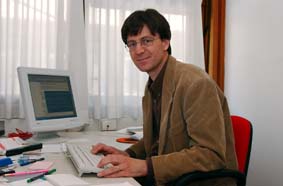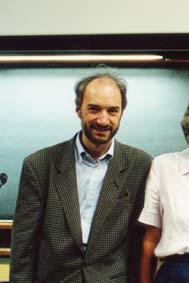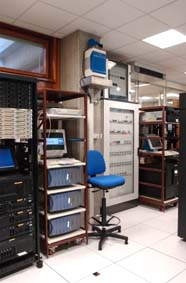Personal tools
News from ICTP 104 - Features - Fast Computers

ICTP has recently joined the race for fast computers. It's a decision likely to help keep researchers throughout the Centre on track.
Fast Computers,
Real Phenomena
No group is more amazed by the
simplicity and beauty of the fundamental laws of physics than
theoretical physicists themselves, particularly when their own
fields of study shed unexpected, yet revealing, light on the variety
and complexity of the laws' manifestation in nature.
How can Schroedinger's equation, a tidy example of mathematical
synthesis, describe the messy arrangement of atoms that compose
the paper that this article is written on? And how can the three
Navier-Stokes equations, which can easily fit on the back of an
envelope, reveal a great deal about the aerodynamics of flight?
Equally interestingly, what is it about the laws of physics that
enable scientists to predict such physical phenomena as climate
dynamics and the creation of such materials as superhard solids
from the bottom up (or perhaps more accurately from the top down)--that
is, from the basic laws of classical and quantum mechanics.
Using computers to solve the fundamental laws of physics and provide
answers to such complex questions has a long history, which began
in the 1940s with the pioneering and visionary work of John von
Neumann at Los Alamos National Laboratory in the USA.
Luckily, human endeavour in this field has been paralleled by
breathtaking increases in the speed and memory of computers. As
a result, such simple problems as a computer synchronising the
rinse-and-spin cycle on a washing machine, which could only be
solved on rudimentary punch-card machines 30 years ago, now require
just a tiny portion of a computer chip for their calculation.
Even more startling to consider is the fact that new computer
processors for desktop PCs experience a doubling of capacity every
18 months, according to Moore's celebrated law, named after Gordon
Moore, the famed co-founder of Intel, who first presented this
insight in 1965.
"Simulating the behaviour of matter at the atomistic scale
by solving Schroedinger's equation is one activity among many
in the very active and prolific field of computational physics,
which has received a tremendous boost over the past 20 years due
to a rapid increase of computer capabilities," says Sandro
Scandolo, one of the newest members of the ICTP condensed matter
physics group. "We can now determine with a high degree of
accuracy the electronic and mechanical properties of solids and
in some cases find interesting surprises."

Sandro Scandolo
Three years ago, for example, a group of scientists at the International
School for Advanced Studies (SISSA) that included Scandolo and
Erio Tosatti, currently ICTP's acting deputy director, discovered
that simulations of the compression of carbon dioxide to one million
atmospheres transformed this inert and innocent gas into superhard
solid material. Their findings immediately prompted a global experimental
search for this new material, which was synthesized the same year
following the same route--extreme compression--by scientists at
Lawrence Livermore National Laboratory, USA.
Climate prediction is another field where computer simulations
are extremely helpful.
"Numerical models of the climate system, including the atmosphere,
oceans and ice caps, have developed to a stage that allows us
to understand the interactions between 'natural' climate variability
and the climatic impacts of human activities," says Franco
Molteni, staff member in the Physics of Weather and Climate group.
"Indeed, simulations developed by the Intergovernmental Panel
on Climate Change (IPCC) projecting future climate scenarios have
been based on numerical models created by some of the most powerful
supercomputers in the world."
But computer simulations are not just an indispensable tool for
high-level scientific research. They have also become a valuable
teaching instrument in universities and research centres in both
the North and the South.
"Computer literacy in most developing countries is growing
at an extremely rapid rate, possibly faster than literacy in the
basic sciences," says Scandolo, "thanks to the internet
and the increasing availability of PCs with high performance and
low cost. We need to take advantage of this global market trend
and turn it into an opportunity to foster education in physics
and other basic sciences in developing countries."
In fact, the improvements in hardware performance are so rapid
that the performance of a $10,000 top-of-the-line processor today
can be replicated in two-years' time by a $1,000 processor in
a desktop PC.
Two years are an extremely brief period on the time-scale of scientific
progress. This means that high-quality scientific achievements
in computationally oriented disciplines can be obtained with financial
investments that are affordable for institutions in less developed
countries. Put another way, money and, consequently, time are
not the obstacles they used to be for scientists who draw on computer-driven
calculations for their research.
Equally encouraging, the rapid narrowing of the performance/cost
ratio for PCs has brought a welcome paradigm shift in the design
of high-performance machines for scientific computing.
In the past, high-performance computers had to be tailored to
the needs of the scientific community. The fastest computers in
the 1970s were constructed explicitly for scientific applications.
Nowadays, parallel computers based on dozens of standard PC processors,
assembled and interconnected with a fast network, provide computational
power that exceeds by orders of magnitude that of the fastest
machines available in the 1970s, satisfying the needs of banks,
insurance companies and scientific institutions alike.
ICTP has taken advantage of this 'building block' approach by
recently acquiring a cluster of 80 PC processors. This cluster
will dramatically boost in-house computational research capabilities--a
turn of events especially welcomed by staff and visiting scientists
in the fields of condensed matter physics and physics of weather
and climate.

Franco Molteni
"We are excited by this opportunity," says Molteni,
"which will give us the ability to test climate simulations
on a time scale of up to 100 years. Also, by running several simulations
based on a variety of conditions, we can distinguish the effects
of the chaotic nature of climate dynamics from the 'greenhouse'
gas and aerosol effects caused by human activities."
"On another research front, a parallel computer with such
a large number of processors will finally allow us to test whether
water becomes metallic at the extreme conditions found in the
interiors of Uranus and Neptune, a speculation that we put forward
a few years ago, but that is still
awaiting confirmation from simulations on a larger scale,"
Scandolo adds.
Ralph Gebauer, also with the Condensed Matter Physics group, has
a different but equally enticing vision of future accomplishment:
"I'd like to understand the physical mechanisms that control
transport and dissipation in molecular junctions, the building
blocks of the future generations of processors." In other
words, Gebauer would like to tap the capabilities of today's computers
to lay the theoretical groundwork for even faster computers in
the future.

ICTP computer bank
Scientific research is often like a marathon--with the winners
usually those who are intellectually fit enough to stay the course.
But progress in this marathon requires the ability to win sprints
as well, and increasingly fast computers provide the 'data track'
you need to stay in the day-by-day competition.
Now, with the recent arrival of in-house fast computers, ICTP
scientists have found themselves in the enviable position of being
able to compete in both the short- and long-distance runs that
increasingly characterise the nature of competition in their fields.
Such an environment has positive implications not just for global
science but for our global community
as well.